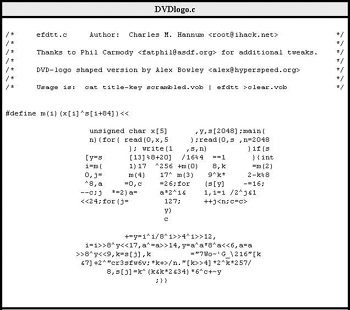Chapter 10: Finding Movies (or TV Shows)
|
| < Day Day Up > |
|
Overview
Never hesitate to steal a good idea.
—Al Neuharth
Soon after people began downloading music, the movie industry saw itself as the next logical target. Yet it felt secure, because movies were too large for most people to trade online easily, and most personal computers didn’t have the hard disk space or processing power to store or view an entire movie file anyway. These technological limitations fell in quick succession in the mid-’90s with the combination of cheaper and larger hard disks that offered several gigabytes of storage; faster processors that could play video files; and most importantly, the widespread adoption of broadband connections that allowed massive movie files to be transferred quickly across the Internet.
Ironically, the switch from storing movies on video cassette (VHS) to DVD marked the final step for Internet movie piracy. Ripping a video off a DVD is much faster and more convenient than ripping that same video off a cassette tape, because you don’t have to scroll through the entire length of a cassette tape to do it.
Initially, the movie industry felt itself secure because when it created the DVD standard, it included something called the Content Scramble System (CSS) to restrict copying and force manufacturers of DVD players to pay royalties to the DVD Copy Control Association (http://www.dvdcca.org). Before anyone can manufacture and sell a DVD player, they must pay for the right to use a special decryption key, which allows their DVD players to play DVDs encrypted with CSS.
Well, many hackers didn’t like that. In late 1999, a hacker group named MoRE (Masters of Reverse Engineering) created a program called DeCSS, which stripped away the CSS encryption from DVDs. Without the CSS protection, not only could DVDs be played on devices that hadn’t paid the required royalty fee, such as computers running Linux, but such DVDs could also be copied as well.
To get your hands on a copy of the DeCSS program or its source code, visit the Free DVD site (http://www.free-dvd.org.lu).
The movie industry promptly sued websites that published the DeCSS code, but programmers struck back. To keep the cracking code well distributed, crafty programmers began hiding the code in works of “illegal art,” including haiku poems, photographs, T-shirt prints, movies, dramatic readings, and other works on display at the Gallery of CSS Descramblers (http://www-2.cs.cmu. edu/~dst/DeCSS/Gallery). The ASCII art in Figure 10-1, for example, contains the source code for cracking a DVD’s encryption.

Figure 10-1: This ASCII art lists the source code for cracking a DVD’s encryption.
A few years later, the movie industry accidentally let the code out of the bag by including the cracked code’s full text in a public legal filing. Once made public, the code spread worldwide, eventually becoming so commonplace that the industry dropped its suit in 2004. Not that it mattered much. Today, most movies appear on the Internet before they’ve been distributed on a DVD or even before their theatrical release. Once a copy leaks onto the Internet, it quickly spreads worldwide.
|
| < Day Day Up > |
|
EAN: 2147483647
Pages: 98